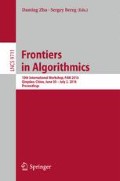Abstract
Breakpoint graph is a key data structure to study genome rearrangements. The problem of Breakpoint Graph Decomposition (BGD), which asks for a largest collection of edge-disjoint cycles in a breakpoint graph, is a crucial step in computing rearrangement distances between genomes. This problem for genomes of unsigned genes is proved NP-hard, and the best known approximation ratio is 1.4193+\(\epsilon \) [1]. In this paper, we present a polynomial time algorithm to detect whether a breakpoint graph can be decomposed into none other than 2-cycles. Our algorithm can be used to detect if there exists a sorting scenario between two genomes without reusing any breakpoints.
Access this chapter
Tax calculation will be finalised at checkout
Purchases are for personal use only
References
Lin, G., Jiang, T.: A further improved approximation algorithm for breakpoint graph decomposition. J. Comb. Optim. 8(2), 183–194 (2004)
Kececioglu, J., Sankoff, D.: Exact and approximation algorithms for the inversion distance between two chromosomes. Comb. Pattern Matching Fourth Ann. Symp. 684, 87–105 (1993)
Caprara, A.: Sorting by reversals is difficult. In: Proceedings of the First Annual International Conference on Computational Molecular Biology (1997)
Hannenhalli, S., Pevzner, P.A.: Transforming cabbage into turnip (polynomial algorithm for sorting signed permutations by reversals). In: Proceedings of 27th Annual ACM Symposium on Theory of Comput (STOC) (1995)
Caprara, A.: On the tightness of the alternating-cycle lower bound for sorting by reversals. J. Comb. Optim. 3(2), 149–182 (1999)
Swenson, K.M., Lin, Y., Rajan, V., Moret, B.M.E.: Hurdles and sorting by inversions: combinatorial, statistical, and experimental results. J. Comput. Biol. 16(10), 1339–1351 (2009)
Swenson, K.M., Lin, Y., Rajan, V., Moret, B.M.E.: Hurdles hardly have to be heeded. In: Nelson, C.E., Vialette, S. (eds.) RECOMB-CG 2008. LNCS (LNBI), vol. 5267, pp. 241–251. Springer, Heidelberg (2008)
Hannenhalli, S.: Polynomial-time algorithm for computing translocation distance between genomes. Proc. Sixth Ann. Symp. Comb. Pattern Matching (CPM) 937, 162–176 (1995)
Kececioglu, J., Ravi, R.: Of mice and men: algorithms for evolutionary distances between genomes with translocation. In: Proceedings Sixth Annual ACM-SIAM Symposium, Discrete Algorithms (SODA) (1995)
Jiang, H., Zhu, B., Zhu, D.: Algorithms for sorting unsigned linear genomes by the DCJ operations. Bioinformatics 27(3), 311–316 (2010)
Chen, X., Zheng, J., Fu, Z., Nan, P., Zhong, Y., Lonardi, S., Jiang, T.: Assignment of orthologous genes via genome rearrangement. ACM/IEEE Trans. Comput. Bio. Bioinf. 2(4), 302–315 (2005)
Shao, M., Lin, Y., Moret, B.: An exact algorithm to compute the DCJ distance for genomes with duplicate genes. In: Sharan, R. (ed.) RECOMB 2014. LNCS, vol. 8394, pp. 280–292. Springer, Heidelberg (2014)
Chen, Z., Fu, B., Zhu, B.: The approximability of the exemplar breakpoint distance problem. In: Cheng, S.-W., Poon, C.K. (eds.) AAIM 2006. LNCS, vol. 4041, pp. 291–302. Springer, Heidelberg (2006)
Ma, J., Ratan, A., Raney, B.J., Suh, B.B., Miller, W., Haussler, D.: The infinite sites model of genome evolution. Proc. Nat. Acad. Sci. 105(38), 14254–14261 (2008)
Author information
Authors and Affiliations
Corresponding author
Editor information
Editors and Affiliations
Rights and permissions
Copyright information
© 2016 Springer International Publishing Switzerland
About this paper
Cite this paper
Pu, L., Jiang, H. (2016). Can a Breakpoint Graph be Decomposed into None Other Than 2-Cycles?. In: Zhu, D., Bereg, S. (eds) Frontiers in Algorithmics. FAW 2016. Lecture Notes in Computer Science(), vol 9711. Springer, Cham. https://doi.org/10.1007/978-3-319-39817-4_20
Download citation
DOI: https://doi.org/10.1007/978-3-319-39817-4_20
Published:
Publisher Name: Springer, Cham
Print ISBN: 978-3-319-39816-7
Online ISBN: 978-3-319-39817-4
eBook Packages: Computer ScienceComputer Science (R0)

